coolant temperature OLDSMOBILE SILHOUETTE 1998 Owners Manual
[x] Cancel search | Manufacturer: OLDSMOBILE, Model Year: 1998, Model line: SILHOUETTE, Model: OLDSMOBILE SILHOUETTE 1998Pages: 444, PDF Size: 23.2 MB
Page 131 of 444
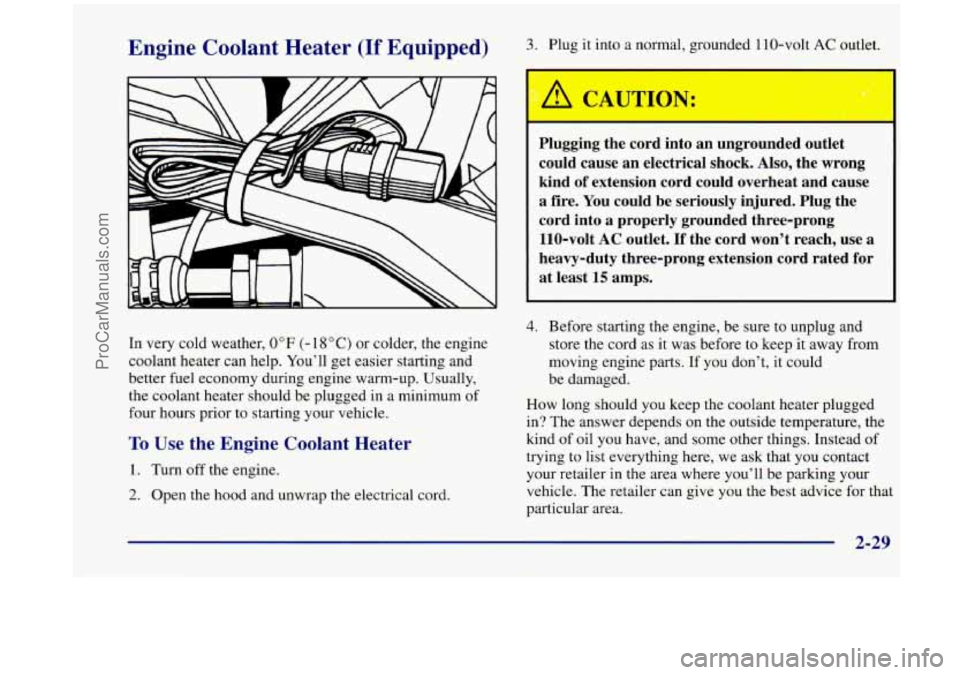
Engine Coolant Heater (If Equipped) 3. Plug it into a normal, grounded 110-volt AC outlet.
Plugging the cord into
an ungrounded outlet
could cause an electrical shock. Also, the wrong
kind
of extension cord could overheat and cause
a fire. You could be seriously injured. Plug the
cord into
a properly grounded three-prong
110-volt
AC outlet. If the cord won’t reach, use a
heavy-duty three-prong extension cord rated for
at least
15 amps.
In very cold weather,
0°F (- 18 “C) or colder, the engine
coolant heater can help. You’ll get easier starting and
better fuel economy during engine warm-up. Usually,
the coolant heater should be plugged in a minimum of
four hours prior to starting your vehicle.
To Use the Engine Coolant Heater
1. Turn off the engine.
2. Open the hood and unwrap the electrical cord.
4. Before starting the engine, be sure to unplug and
store the cord as it was before to keep it away from
moving engine parts.
If you don’t, it could
be damaged.
How long should
you keep the coolant heater plugged
in? The answer depends on the outside temperature, the
kind
of oil you have, and some other things. Instead of
trying to list everything here, we ask that you contact
your retailer in the area where you’ll be parking your
vehicle. The retailer can give
you the best advice for that
particular area.
2-29
ProCarManuals.com
Page 194 of 444
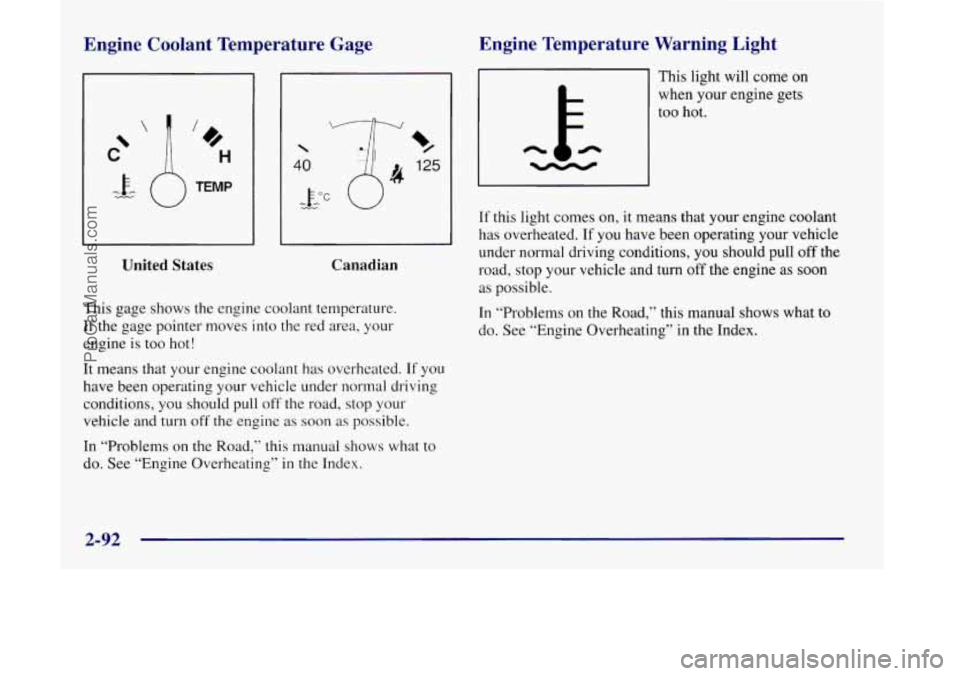
Engine Coolant Temperature Gage
United States
~~
Canadian
This gage shows the engine coolant temperature.
If the gage pointer moves into the red area, your
engine
is too hot!
It means that your engine coolant has overheated. If you
have been operating your vehicle under normal driving
conditions, you should pull
off the road, stop your
vehicle and turn
off the engine as soon as possible.
In “Problems on the Road,” this manual
shows what to
do. See “Engine Overheating”
in the Index.
Engine Temperature Warning Light
b This light will come on
when your engine gets
too
hot.
v
If this light comes on, it means that your engine coolant
has overheated. If
you have been operating your vehicle
under normal driving conditions, you should pull
off the
road, stop your vehicle and turn off the engine
as soon
as possible.
In “Problems on the Road,” this manual shows what
to
do. See “Engine Overheating” in the Index.
2-92
ProCarManuals.com
Page 208 of 444
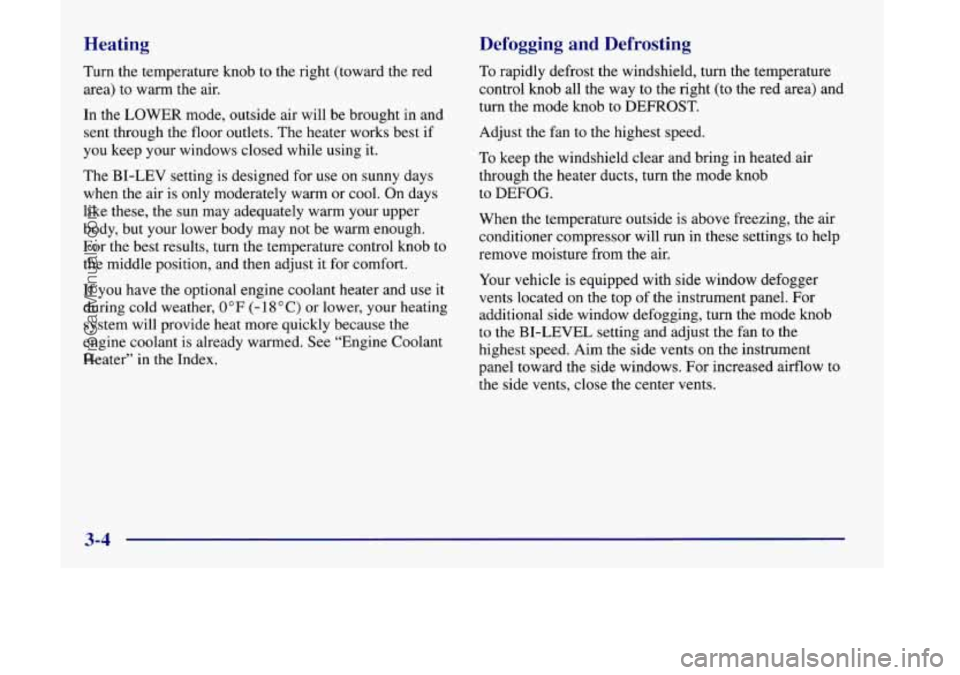
Heating
Turn the temperature knob to the right (toward the red
area) to warm the air.
In the LOWER mode, outside air will be brought in and
sent through the floor outlets.
The heater works best if
you keep your windows closed while using it.
Defogging and Defrosting
To rapidly defrost the windshield, turn the temperature
control knob all the way to the right (to the red area) and
turn the mode
knob to DEFROST.
The BI-LEV setting
is designed for use on sunny days
when the air is only moderately warm or cool. On days
like these, the sun may adequately warm your upper
body, but your lower body may not be
warm enough.
For the best results, turn the temperature control knob
to
the middle position, and then adjust it for comfort.
If
you have the optional engine coolant heater and use it
during cold weather, 0 “F (- 18 O C) or lower, your heating
system will provide heat more quickly because the
engine coolant is already warmed. See “Engine Coolant
Heater” in
the Index. Adjust the
fan to the highest speed.
To keep the windshield clear and bring in heated air
through the heater ducts, turn the mode knob
to DEFOG.
When the temperature outside
is above freezing, the air
conditioner compressor will run in these settings to help
remove moisture from the air.
Your vehicle is equipped with side window defogger
vents located
on the top of the instrument panel. For
additional side window defogging, turn the mode knob
to the BI-LEVEL setting and adjust the fan to the
highest speed. Aim the
side vents on the instrument
panel toward the side windows. For increased airflow to
the side vents, close the center vents.
3-4
ProCarManuals.com
Page 287 of 444
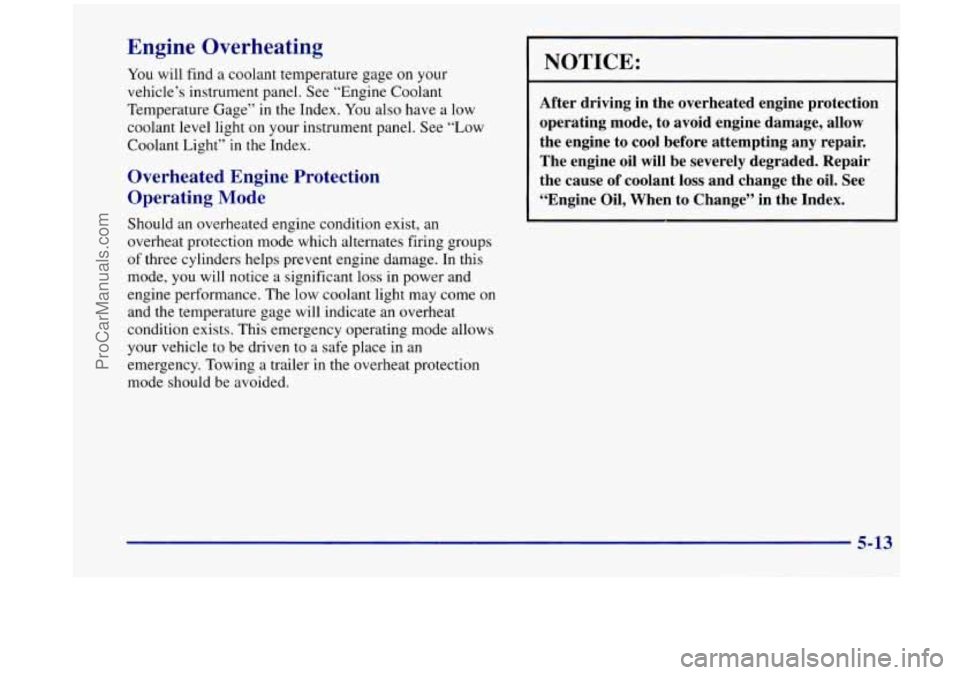
Engine Overheating
You will find a coolant temperature gage on your
vehicle’s instrument panel. See “Engine Coolant
Temperature Gage” in the Index. You also have a low
coolant level light on your instrument panel. See “LOW
Coolant Light” in the Index.
Overheated Engine Protection
Operating Mode
Should an overheated engine condition exist, an
overheat protection mode which alternates firing groups
of three cylinders helps prevent engine damage. In this
mode, you will notice a significant loss in power and
engine performance. The
low coolant light may come on
and the temperature gage will indicate an overheat
condition exists. This emergency operating mode allows
your vehicle to be driven to a safe place in an
emergency. Towing a trailer in the overheat protection
mode should be avoided.
1 NOTICE:
After driving in the overheated engine protection
operating mode, to avoid engine damage, allow
the engine to cool before attempting any repair.
The engine oil will be severely degraded. Repair
the cause of coolant loss and change the oil. See
“Engine Oil, When to Change” in the Index.
ProCarManuals.com
Page 331 of 444
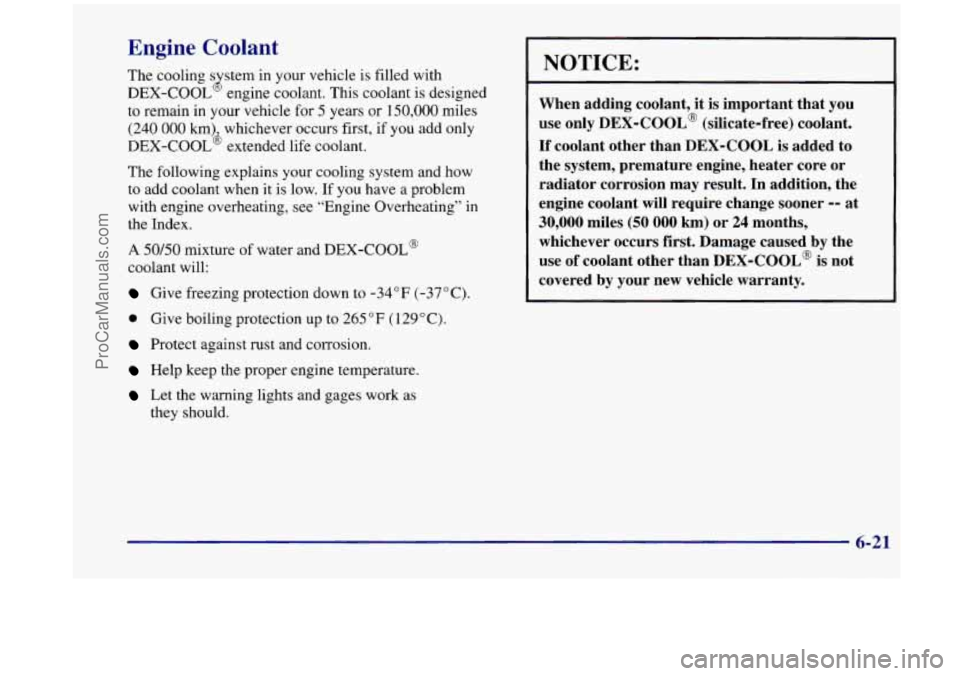
Engine Coolant
The cooling s stem in your vehicle is filled with
DEX-COOL engine coolant. This coolant is designed
to remain in your vehicle for
5 years or 150,000 miles
(240 000 lunb whichever occurs first, if you add only
DEX-COOL extended life coolant.
J
The following explains your cooling system and how
to add coolant when it is low. If you have a problem
with engine overheating, see “Engine Overheating” in
the Index.
A 50/50 mixture of water and DEX-COOL@
coolant will:
Give freezing protection down to -34°F (-37°C).
0 Give boiling protection up to 265 OF (1 29 O C).
Protect against rust and corrosion.
Help keep the proper engine temperature.
Let the warning lights and gages work as
they should.
NOTICE:
When adding coolant, it is important that you
use only
DEX-COOL@ (silicate-free) coolant.
If coolant other than DEX-COOL is added to
the system, premature engine, heater core or
radiator corrosion may result. In addition, the
engine coolant will require change sooner
-- at
30,000 miles (50 000 km) or 24 months,
whichever occurs
first. Damage caused by the
use of coolant other than DEX-COOL@ is not
covered by your new vehicle warranty.
6-21
ProCarManuals.com
Page 334 of 444

1 Add coolant mixture at the recovery tank, but be careful
~ not to spill it.
~
You can be burned if you spill coolant on hot
engine parts. Coolant contains ethylene glycol,
and
it will burn if the engine parts are hot
enough. Don’t spill coolant on
a hot engine.
_- -
When you replace your radiator pressure cap, a GM cap
is recommended.
Radiator Pressure Cap
NOTICE:
Your radiator cap is a 15 psi (105 kPa)
pressure-type cap and must be tightly installed to
prevent coolant loss and possible engine damage
from overheating. Be
sure the arrows on the cap
line up with the overflow tube on the radiator
filler neck.
Thermostat
Engine coolant temperature is controlled by a thermostat
in the engine coolant system. The thermostat
stops the
flow of coolant through the radiator until the coolant
reaches a preset temperature.
When you replace your thermostat, a
GM thermostat
is recommended.
1 6-24
I I
ProCarManuals.com
Page 336 of 444

Windshield Washer Fluid
What to Use
When you need windshield washer fluid, be sure to read
the manufacturer’s instructions before use. If you will
be
operating your vehicle in an area where the temperature
may fall below freezing, use a fluid that has sufficient
protection against freezing.
Adding Washer Fluid
The windshield washer
fluid reservoir is located on
the passenger’s side
of the
vehicle, near the fuse and
relay center.
NOTICE:
Open the cap labeled WASHER FLUID ONLY. Add
washer fluid until the tank
is full.
0
0
0
0
When using concentrated washer fluid,
follow the manufacturer’s instructions for
adding water.
Don’t mix water with ready-to-use washer
fluid. Water can cause the solution to freeze and damage your washer fluid tank and
other parts of the washer system.
Also,
water doesn’t clean as well as washer fluid.
Fill your washer fluid tank only
three-quarters full when it’s very cold.
This allows
for expansion if freezing occurs,
which could damage the tank if it is
completely full.
Don’t use engine coolant (antifreeze) in
your windshield washer. It can damage
your washer system and paint.
6-26
ProCarManuals.com
Page 396 of 444

1 Short Trip/City Maintenance Schedule I
POS,OOO Miles (166 000 km)
Inspect spark plug wires. An Emission Control Service.
0 Replace spark plugs. An Emission Control Service.
0 Change automatic transaxle fluid and filter if the vehicle is mainly driven
under
one or more of these conditions:
- In heavy city traffic where the outside temperature regularly reaches 90°F
(32 O C) or higher.
- In hilly or mountainous terrain.
- When doing frequent trailer towing.
- Uses such as found in taxi, police or delivery service.
If you do not use your vehicle under any of these conditions, the fluid and
filter
do not require changing.
150,000 Miles (240 000 km)
0 Drain, flush and refill cooling system (or every 60 months since last service,
whichever occurs first). See “Engine Coolant” in the Index for what to
use.
Inspect hoses. Clean radiator, condenser, pressure cap and neck. Pressure test
cooling system and pressure cap.
An Emission Control Service.
DATE
I MILEAGE ACTUAL I SERVICEDBY: I
DATE 1
MILEAGE
ACTUAL SERVICED BY:
7-20
ProCarManuals.com
Page 404 of 444

I Long Tripmighway Maintenance Schedule
100,000 Miles (I66 000 km)
0 Inspect spark plug wires.
0 Replace spark plugs.
0 Change automatic transaxle fluid and filter if the vehicle is mainly driven
An Emission Control Service.
An Emission Control Service.
under one or more of these conditions:
- In heavy city traffic where the outside temperature regularly reaches 90°F
- In hilly or mountainous terrain.
(32°C) or
higher.
I DATE I
- When doing frequent trailer towing.
- Uses such as found in taxi, police or delivery service.
If you do not use your vehicle under any of these conditions, the fluid and
filter do not require changing.
150,000 Miles (240 000 km)
0 Drain, flush and refill cooling system (or every 60 months since last service,
whichever occurs first). See “Engine Coolant’’ in the Index for what to
use.
Inspect hoses. Clean radiator, condenser, pressure cap and neck. Pressure test
the cooling system and pressure cap.
An Emission Control Service.
MILEAGE
7-28
ProCarManuals.com
Page 430 of 444
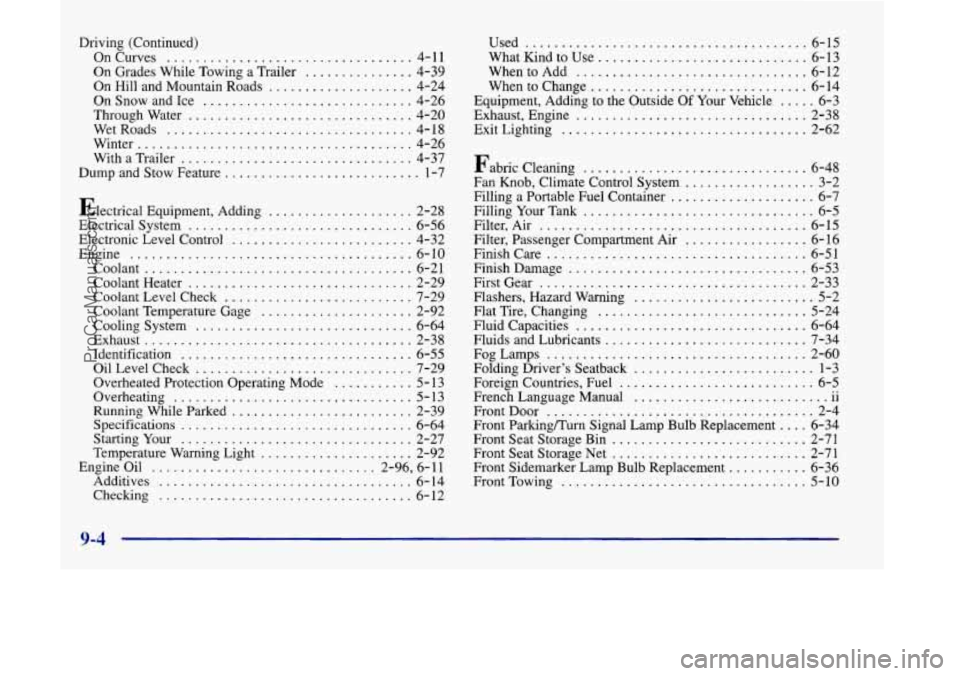
Driving (Continued)
On Curves
.................................. 4- 11
On Grades While Towing a Trailer ............... 4-39
On Hill and Mountain Roads
.................... 4-24
On Snow and Ice
............................. 4-26
Throughwater
............................... 4-20
WetRoads
.................................. 4-18
Winter
...................................... 4-26
With a Trailer
................................ 4-37
Dump and
Stow Feature ........................... 1-7
Electrical Equipment. Adding .................... 2-28
Electrical System
............................... 6-56
Electronic Level Control
......................... 4-32
Engine
....................................... 6-10
Coolant ..................................... 6-21
Coolant Heater
............................... 2-29
Coolant Level Check
.......................... 7-29
Coolant Temperature Gage
..................... 2-92
Cooling System
.............................. 6-64
Exhaust
..................................... 2-38
Identification
................................ 6-55
OilLevelCheck
.............................. 7-29
Overheated Protection Operating Mode
........... 5- 13
Overheating
................................. 5-13
Specifications
................................ 6-64
StartingYour
................................ 2-27
Temperature Warning Light
..................... 2-92
Additives
................................... 6-14
Checking
................................... 6-12
Running
While Parked
......................... 2-39
Engine Oil
............................... 2-96. 6-11 Used
....................................... 6-15
What Kind to Use
............................. 6-13
WhentoAdd
................................ 6-12
Equipment. Adding to the Outside
Of Your Vehicle ..... 6-3
When
to Change
.............................. 6-14
Exhaust. Engine ................................ 2-38
Exit Lighting
.................................. 2-62
Fabric Cleaning
............................... 6-48
Fan Knob. Climate Control System
.................. 3-2
Filling a Portable Fuel Container
.................... 6-7
Filling Your Tank
................................ 6-5
Filter. Air
..................................... 6-15
Filter. Passenger Compartment Air
................. 6-16
Finishcare
.................................... 6-51
Finish Damage
................................. 6-53
FirstGear
..................................... 2-33
Flashers. Hazard Warning
......................... 5-2
Flat Tire. Changing
............................. 5-24
Fluid Capacities
................................ 6-64
FogLmps
.................................... 2-60
Folding Driver’s Seatback
......................... 1-3
Foreign Countries. Fuel
........................... 6-5
FrenchLanguage Manual
11
FrontDoor ..................................... 2-4
Front Parking/Turn Signal Lamp Bulb Replacement
.... 6-34
Front Seat Storage Bin
........................... 2-71
Front Seat Storage Net
........................... 2-71
Front Sidemarker Lamp Bulb Replacement
........... 6-36
FrontTowing
.................................. 5-10
Fluids and Lubricants
............................ 7-34
.. ...........................
9-4
.
ProCarManuals.com